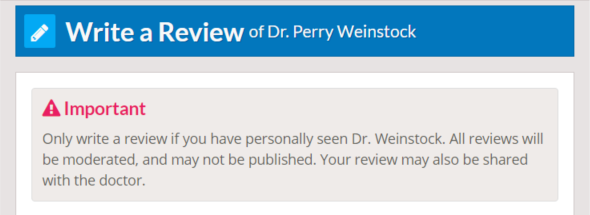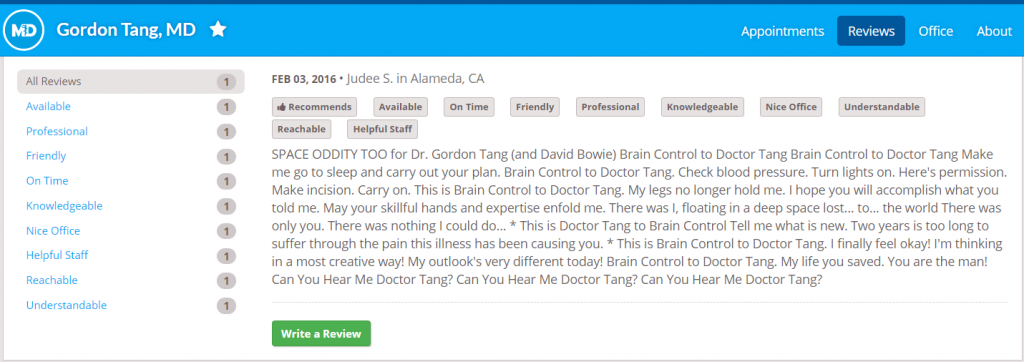How to Write a Good Doctor Review Online

Businesses have been the subject of online reviews for many years, and doctors are no different. For many years, most people have depended on referrals from their doctor, or recommendations from friends and loved ones when choosing a new doctor or specialist.
But, what happens when you need to visit a specialist that friends and family haven’t yet seen? How do you know which doctor to choose? More and more people are turning to online reviews in order to find the doctor that’s right for them.
In 2015, 92% of consumers read online reviews about a local business (which includes reviews about physicians). Moreover, 68% of consumers say that reviews make them trust a local business more. While these numbers aren’t specific to healthcare, they can give you an idea of just how important online reviews are to consumers, and perhaps especially so for those seeking out a new doctor.
Tips for Writing a Useful Doctor Review / Rating
Many people search the web for tips on how to write a good doctor review before actually reviewing or rating a physician themselves. Because we’ve had some experience moderating doctor reviews that have been submitted to MD.com, we wanted to share some best practices and tips on how to make your review the best it can be.
Before Getting Started
First, decide where you’ll submit your review (which website) — if there’s a site that doesn’t have any reviews for your doctor, consider submitting there.
- Read the website’s instructions, tips or FAQ about reviews.
- Read the site’s Terms & Conditions and Privacy Policy.
- Read reviews that others have already left for that doctor on the website you’re submitting to (if any have been published)
- Not to influence your own review, but to see if there’s anything specific from your experience with the physician that you can contribute that will add additional value (as opposed to reiterating or reaffirming what others have already posted).
The Review, Testimonial and/or Rating Process
Getting Started
Get started by following any on-page directions & prompts to begin answering the questions you’re presented, or writing the content of your review. Look out for any warnings, such as this one that we use on MD.com:

Pictured above: The disclaimer / warning we display on review forms at MD.com.
Writing a Testimonial or Review of Your Doctor
Tips to keep in mind…
If and when it comes time to sit down and write the actual content of a review or testimonial, consider these tips:

Above: The nine “review tags” we use at MD.com (screenshot from a review form)
Questions to ask yourself…
Asking yourself questions like these can help stimulate the writing process and help you come up with what to write in the body of an actual doctor review or testimonial:
- How easy was it to schedule an appointment?
- Was it was easy to get in touch with the doctor by phone?
- Was the doctor on time for your appointment?
- What type of bedside manner did the doctor have?
- What did you like about the overall experience?
- Is there anything the doctor could have improved upon?
- Would you recommend the doctor to a friend or family member?
- Did you have any trouble with billing or insurance?
Minding your style and tone…
When writing the body or content of a review or testimonial, remember to be concise but informative. While every review is going to be subjective by its very nature, try your best to write it from an objective point of view.
- When submitting a positive review (which could be considered or referred to as a “testimonial“), be sure to include more than just “Dr. X is great doctor!!!!!” — explain why you feel they’re a great doctor, or what they did to make you feel that way.
- Alternatively, if you’re submitting a not-so-positive review, refrain from making personal attacks or cast aspersions. Instead, offer some constructive criticism based on your own experience that can help the doctor or office improve the next patient’s experience.Remember: Resorting to name-calling and making allegations that can’t be proven will probably be a waste of your time, as doing so will often prevent your review from being published, depending on the policies or screening process of website you’re submitting to.
Some Final Notes & Pointers
An example of a very creative review…
Below, see a screenshot of a review for Dr. Gordon Tang, a neurosurgeon in Berkeley, California — it’s one of our favorites. The patient took the time to write and submit this review to the tune of David Bowie’s “Space Oddity.”
While this isn’t the most “helpful” review when it comes to anecdotal value, it’s by far one of the most creative we’ve ever received (and published). The fact that a patient was inspired to come up with such a creative way of reviewing the doctor tells us they must have had a really positive experience with the doctor.

Screenshot of the review published on Dr. Tang’s MD.com site


